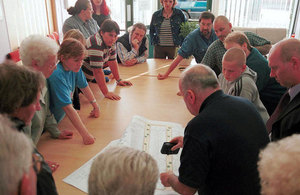Planning reforms put power back in the hands of local residents
Brandon Lewis announces new powers that will make it easier for residents to take control of their neighbourhood.

Neighbourhood planning
The New Year will bring new powers to make it quicker and easier for communities to create their own neighbourhood plan, says Housing and Planning Minister Brandon Lewis.
More than 5.2 million people live in one of the 1,274 areas across England where the community is working together to create a neighbourhood plan.
But agreeing an area for a neighbourhood plan to cover takes an average of 19 weeks.
Today’s (31 December 2014) measures will cut weeks off this process – encouraging even more communities to have a greater say over the future development of their area.
Making it easier for residents to take control of their neighbourhood
More than 160 communities have been consulted on draft neighbourhood plans with 31 plans now in force and used for determining planning applications.
These frontrunners include:
Arundel, West Sussex
The neighbourhood plan approves proposals to turn disused buildings into office space, and supports the development of business within the built up area boundary of the market town.
The plan also encourages the use and development of ‘Live Work Units’ that are especially suited to small businesses in the arts and cultural sectors, which are common to Arundel.
Cringleford, Norfolk
The community has identified priority projects that the parish council will fund using community infrastructure levy money. These include playing fields and changing facilities, an extension to the community centre, new allotments and a community orchard.
In areas where the community infrastructure levy has been adopted, communities with a neighbourhood plan in place will benefit from 25% of the levy revenues arising from the development that takes place in their area.
Woodcote in the Chilterns
In previous surveys of residents around 70% of respondents regularly said ‘no’ to any new housing in the village. Earlier this year, 91% of residents voted ‘yes’ at referendum to a neighbourhood plan allocating land for 76 homes across 5 sites.
Thame, Oxfordshire
The neighbourhood plan allocates 770 new homes to 6 sites dispersed around the Oxfordshire market town, departing from the local planning authority’s proposal to put almost all of the housing on one site on the edge of Thame.
The plan also sets out what infrastructure (such as roads, schools and community facilities) are needed to make development acceptable.
Exeter St. James Forum
Has produced a successful neighbourhood plan and created a community trust to deliver the projects identified in the plan.
Their first successful project was the regeneration of the Queen’s Crescent Gardens, and new projects include the development of sustainable homes, improving allotments and heritage walks in a neighbourhood close to the centre of Exeter.
Felpham, Sussex
The neighbourhood plan protects 8 areas of local green space in the Sussex seaside village. The spaces have been identified for their environmental, recreational, or historic significance to the community, and no development will be permitted on them except in very special circumstances.
Today’s changes will enable even more communities to follow in their footsteps: councils will have just 13 weeks to consider a community’s application to create a neighbourhood area.
This timeframe is reduced to 8 weeks where the neighbourhood area follows a parish boundary, and where applications cover an area straddling more than one planning authority the period for consideration will be extended to 20 weeks.
But the government is also clarifying the information that must be submitted with the neighbourhood plan. This will ensure independent examiners have sufficient information to assess the plan’s environmental effect.
Housing Minister Brandon Lewis said:
We’re seeing a genuine neighbourhood planning movement with communities in almost two-thirds of local authorities already using these powers to shape what gets built where in their local area. This means more than 5 million people now live in a neighbourhood planning area and so far there have been some great proposals from renovating disused building to creating new community orchards and playing fields.
Now I want to go further and see more communities making the most of the powers we’ve put in their hands. Today’s measures will speed up the process, making it quicker and easier to get a neighbourhood plan together so that the views of local people are written clearly in black and white for developers and councils to see, and ensure that future development in those areas delivers the homes communities themselves want to see.
And I want to look at what more can be done to speed up the neighbourhood planning process through further consultation with communities.
Today the government has published its response on neighbourhood planning measures in the 2014 technical consultation on planning. This posed questions about how to make it easier for residents and business to come together to produce a neighbourhood plan or a neighbourhood development order.
Office address and general enquiries
2 Marsham StreetLondon
SW1P 4DF
Contact form https://www.gov.uk/gui...
General enquiries: please use this number if you are a member of the public 030 3444 0000
If your enquiry is related to COVID-19 please check our guidance page first before you contact us - https://www.gov.uk/guidance/coronavirus-covid-19-guidance-for-local-government.
If you still need to contact us please use the contact form above to get in touch, because of coronavirus (COVID-19). If you send it by post it will not receive a reply within normal timescale.
Media enquiries
Email newsdesk@communities.gov.uk
Please use this number if you are a journalist wishing to speak to Press Office 0303 444 1209